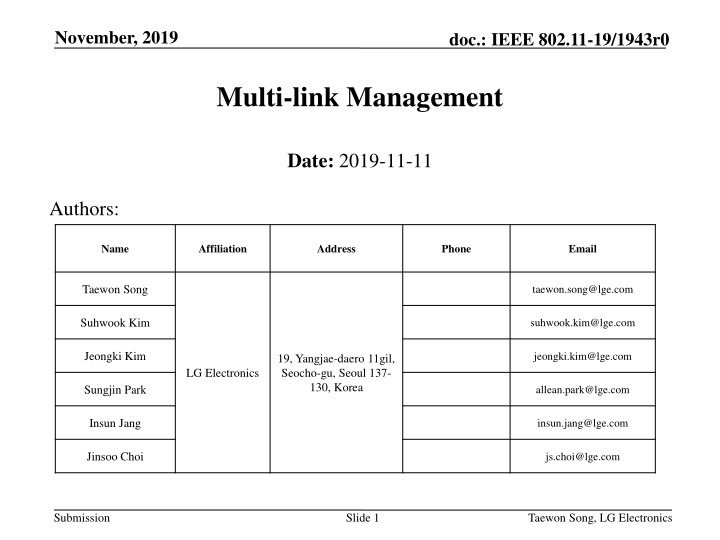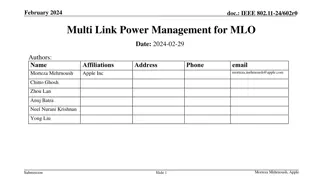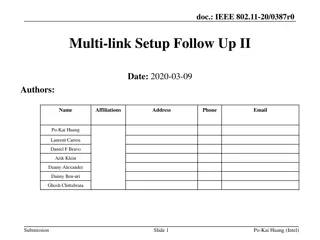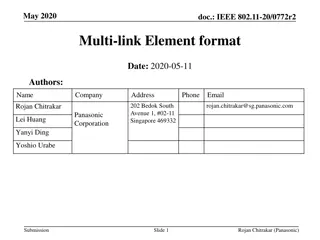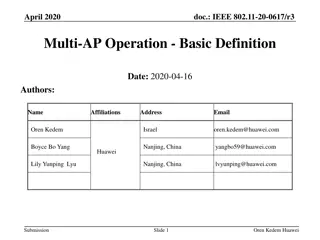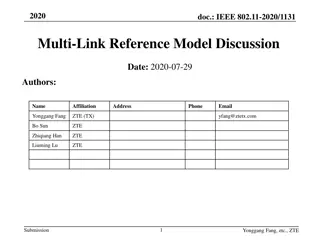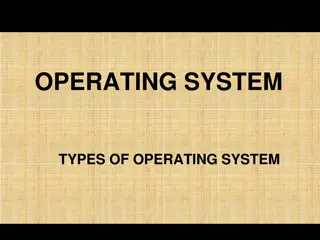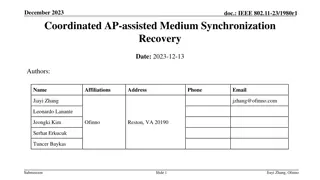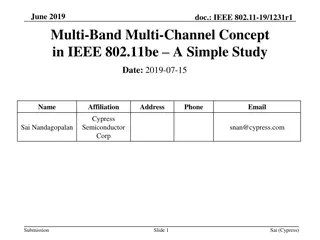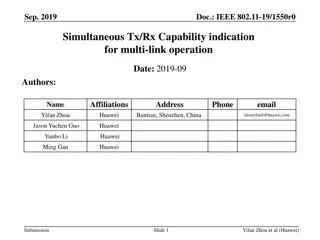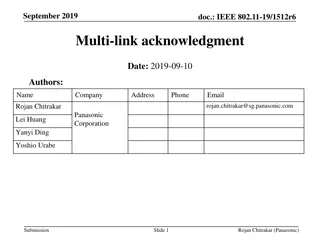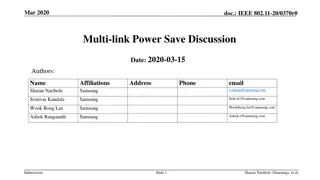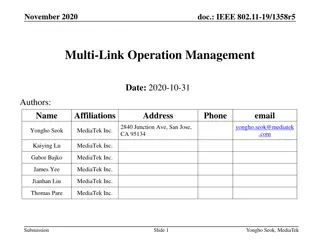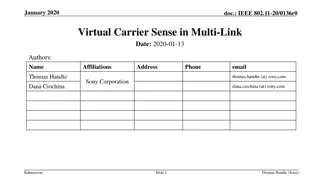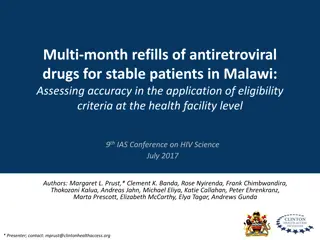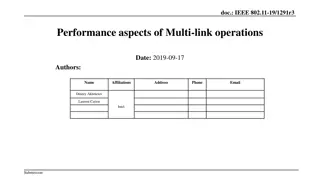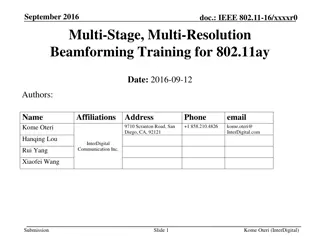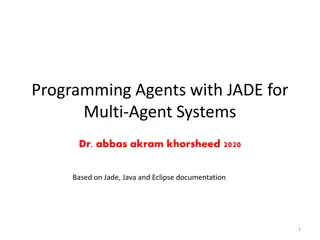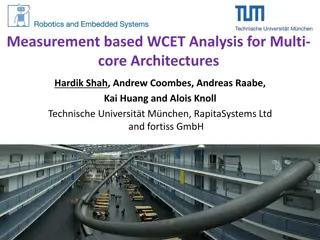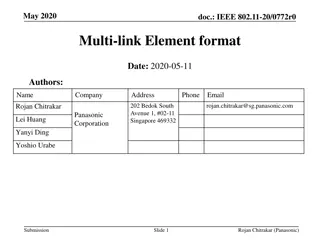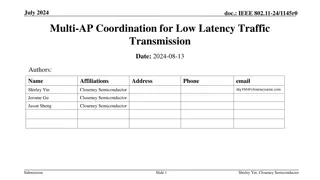Multi-link Management
This document discusses multi-link management in IEEE 802.11-19/1943r0, addressing key usage cases, terminologies, turning off links, and alternating active links within a multi-band wireless network environment. The content focuses on procedures and considerations for optimizing performance and power efficiency in multi-band scenarios.
Download Presentation

Please find below an Image/Link to download the presentation.
The content on the website is provided AS IS for your information and personal use only. It may not be sold, licensed, or shared on other websites without obtaining consent from the author.If you encounter any issues during the download, it is possible that the publisher has removed the file from their server.
You are allowed to download the files provided on this website for personal or commercial use, subject to the condition that they are used lawfully. All files are the property of their respective owners.
The content on the website is provided AS IS for your information and personal use only. It may not be sold, licensed, or shared on other websites without obtaining consent from the author.
E N D
Presentation Transcript
November, 2019 doc.: IEEE 802.11-19/1943r0 Multi-link Management Date: 2019-11-11 Authors: Name Affiliation Address Phone Email Taewon Song taewon.song@lge.com Suhwook Kim suhwook.kim@lge.com Jeongki Kim jeongki.kim@lge.com 19, Yangjae-daero 11gil, Seocho-gu, Seoul 137- 130, Korea LG Electronics Sungjin Park allean.park@lge.com Insun Jang insun.jang@lge.com Jinsoo Choi js.choi@lge.com Submission Slide 1 Taewon Song, LG Electronics
November, 2019 doc.: IEEE 802.11-19/1943r0 Motivation Some key usage cases are proposed with multi-band capability [1-3] Steering/load balancing, aggregation, AP power save, coexistence with other stds, QoS, etc. In this contribution, we suggest some procedures for the above- mentioned usage cases for multi-band and address some considerations Submission Slide 2 Taewon Song, LG Electronics
November, 2019 doc.: IEEE 802.11-19/1943r0 Recap on Terminologies [1-2] Multi-link AP logical entity AP 1 on 2.4 GHz AP 2 on 5 GHz AP 3 on 6 GHz Disabled multi-link set Link 1 Link 2 Link 3 Enabled multi-link set Supported multi-link set STA 1 on 2.4 GHz STA 2 on 5 GHz STA 3 on 6 GHz Multi-link non-AP logical entity Submission Slide 3 Taewon Song, LG Electronics
November, 2019 doc.: IEEE 802.11-19/1943r0 Turning off links A STA MLLE can turn off some of its operating links A STA MLLE can turn off its radio to save the power with existing disassociation procedure When the STA wants to turn on Link 1 again, association may not be required If parameter update is needed, it can be performed on Link 2 or Link 3 in advance Multi-link AP logical entity AP 1 on 2.4 GHz Multi-link AP logical entity AP 1 on 2.4 GHz AP 2 on 5 GHz AP 3 on 6 GHz AP 2 on 5 GHz AP 3 on 6 GHz Link 1 Link 2 Link 3 Link 1 Link 2 Link 3 STA 1 on 2.4 GHz STA 2 on 5 GHz STA 3 on 6 GHz STA 1 on 2.4 GHz STA 2 on 5 GHz STA 3 on 6 GHz Multi-link non-AP logical entity Multi-link non-AP logical entity Submission Slide 4 Taewon Song, LG Electronics
November, 2019 doc.: IEEE 802.11-19/1943r0 Alternating active links An MLLE can alternate its active link among the supported multi- link set This can be achieved by turning on a link among disabled multi-link set and then turning off a link among enabled multi-link set Multi-link AP logical entity AP 1 on 2.4 GHz Multi-link AP logical entity AP 1 on 2.4 GHz AP 2 on 5 GHz AP 3 on 6 GHz AP 2 on 5 GHz AP 3 on 6 GHz Link 1 Link 2 Link 3 Link 1 Link 2 Link 3 Disconnect Link 2 Establish Link 3 STA 1 on 2.4 GHz STA 2 on 5 GHz STA 3 on 6 GHz STA 1 on 2.4 GHz STA 2 on 5 GHz STA 3 on 6 GHz Multi-link non-AP logical entity Multi-link non-AP logical entity Submission Slide 5 Taewon Song, LG Electronics
November, 2019 doc.: IEEE 802.11-19/1943r0 Switching band of STA with a common radio [3] A STA can operate with a common radio among the supportable links Antennas of the STA with shared radio can use either 5 GHz or 6 GHz Adopting this shared radio can allow the STA to support both bands To this end, link switching procedure needs to be defined Existing channel switching procedure can be reused for this: Extended channel switch announcement element can support channel switch mode (forcing STAs to stop transmissions), new operating class, new channel number, and channel switch count (time period until the channel switch event) Else, a new procedure for link switching can be newly defined Multi-link AP logical entity AP 1 on 2.4 GHz Multi-link AP logical entity AP 1 on 2.4 GHz AP 2 on 5 GHz AP 3 on 6 GHz AP 2 on 5 GHz AP 3 on 6 GHz Link 1 Link 2 Link 3 Link 1 Link 2 Link 3 STA 1 on 6 GHz STA 1 on 5 GHz Multi-link non-AP logical entity Multi-link non-AP logical entity Submission Slide 6 Taewon Song, LG Electronics
November, 2019 doc.: IEEE 802.11-19/1943r0 Switching band of STA with a common radio For some APs with spatial limitation (e.g., Soft AP), an AP may operate with a common radio as well Antennas attached to MLLEs can operate either 5 GHz or 6 GHz It can be achieved by existing channel switching procedure With this band switching, crowded channel can be avoided and traffic load can also be balanced However, in this case, legacy 5 GHz stations would loss their connection Multi-link AP logical entity Multi-link AP logical entity AP 1 AP 2 on 5 GHz AP 1 AP 2 on 6 GHz on 2.4 GHz on 2.4 GHz Link 1 Link 2 Link 1 Link 2 STA 1 on 2.4 GHz STA 2 on 5 GHz STA 1 on 2.4 GHz STA 2 on 6 GHz Multi-link non-AP logical entity Multi-link non-AP logical entity Submission Slide 7 Taewon Song, LG Electronics
November, 2019 doc.: IEEE 802.11-19/1943r0 Switching band of STA with a common radio To overcome this disconnection problem of legacy STAs, a subset of links may remain in the frequency band where they originally existed For instance, assuming AP 1 has 4 antennas, the AP 1 is split into AP 1 and AP 2, and they are allocated on 5GHz and 6GHz, respectively STAs supporting shared radio concept (STA MLLE B) can selectively move to a new AP (AP 2) Legacy STA can maintain its connection with the AP Multi-link AP logical entity Multi-link AP logical entity AP 1 on 5 GHz AP 1 on 5 GHz AP 2 on 6 GHz Link 2 Link 1 Link 1 STA A1 on 5 GHz STA A1 on 5 GHz Multi-link non-AP logical entity A (No shared radio support) Multi-link non-AP logical entity A (No shared radio support) STA B1 on 5 GHz STA B1 on 6 GHz Multi-link non-AP logical entity B (Shared radio support) Multi-link non-AP logical entity B (Shared radio support) Submission Slide 8 Taewon Song, LG Electronics
November, 2019 doc.: IEEE 802.11-19/1943r0 Considerations When it comes to turning off the link to save the power, any explicit signaling may not be needed If an MLLE has a common queue, the MLLE has only to re-map between TID and link On the other hand, if an MLLE has seperated queues over links, seamless transfer may not be possible In case of alternating links, existing reassociation procedure can be used This case is same with the above-mentioned turning off cases If some radios can change its frequency band, this procedure is analogous to existing (extended) channel switching In this case, legacy devices may not be supported due to the switched band To support the legacy devices, a subset of links may remain on the link where they existed To this end, some additional information can be included in addition to existing channel switching Since a BSS is newly created, information regarding the BSS can be announced such as Band Information, NSS, BSSID, Beacon Interval, and so on Some attributes, e.g., NSS, for the remaining AP may be changed and they needs to be announced Submission Slide 9 Taewon Song, LG Electronics
November, 2019 doc.: IEEE 802.11-19/1943r0 Straw Poll 1 Do you agree to add the following text to the TGbe SFD? TGbe shall support that an MLLE can support a non-AP STA which can switch its operating band (e.g., 5 GHz and 6 GHz) Submission Slide 10 Taewon Song, LG Electronics
November, 2019 doc.: IEEE 802.11-19/1943r0 Straw Poll 2 Do you agree to add the following text to the TGbe SFD? TGbe shall support that an MLLE can support an AP STA which can switch its operating band (e.g., 5 GHz and 6 GHz) Submission Slide 11 Taewon Song, LG Electronics
November, 2019 doc.: IEEE 802.11-19/1943r0 References [1] 19/0773r7, Multi-link operation framework [2] 19/1358r0, Multi-link operation management [3] 19/1528r1, Multi-link: Link management Submission Slide 12 Taewon Song, LG Electronics
